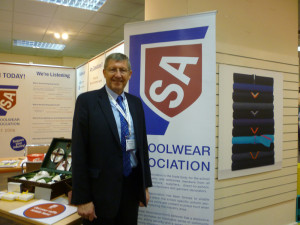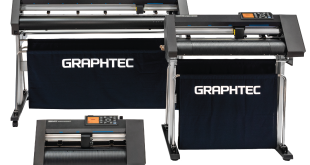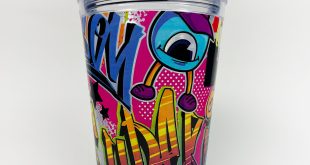
With over 45 years of experience, DAVID BURGESS, chair of the Schoolwear Association and executive chairman of David Luke, knows a thing or two about schoolwear. P&P editor MELANIE ATTLESEY talks trends, the market and The Schoolwear Show 2015.
As we approach Christmas, the back to school rush for many may seem like a distant memory as they swiftly move on to the next season. Last month the schoolwear industry gathered once again at The Schoolwear Show at Cranmore Park, Solihull, where many new styles, trends and products were on display.
Trends
The schoolwear market is continuously growing and evolving, meaning that those involved have to keep up to date with the latest trends and changes. There are now more than 4,500 academies in England alone, with many of these opting to dress their pupils in business-like attire, which is influencing what garments are now flying off retailer’s shelves.
As David explains: “Schools see their name and logo as their brand and their identity, which they want to promote in the best possible light. Academies are driving forward this change in school uniform, but many state schools are also moving from sweatshirts to blazers, as this promotes a better sense of professionalism.” Enforcing a school uniform policy is essential to a child’s education, says David, as it ensures that all pupils are dressed the same so no child can be ostracised for the clothes they wear.
This desire by schools for their pupils to look smart in the classroom is now spilling out onto the playing fields and the sports halls of schools around the country, which David believes has led to the rise in specialised sports kits. This comes down to schools wanting to build a sense of belonging for their pupils both in and out of the classroom. As David explains: “Schools themselves don’t like sports brands, because they become divisive within the school. But they do like their own brand, because this becomes inclusive for the children and strengthens their sense of belonging. This is the purpose of a school uniform. Sports kits are now becoming as important to the learning process as a school uniform. Schools want their pupils to be proud of the school they belong to.”
Another factor influencing school uniform trends is the rise in the number of obese children in the UK. According to Public Health England around 19% of children aged 10 to 11 are classed as obese, this brings about the need for larger sized school uniforms. A few years ago schoolwear manufacturers were making special sized garments to cater for larger children, but now because the demand is there and growing they are now stocking a 52in chest size as standard and a 44in waist in trousers as standard. David also points out that sizes are becoming increasingly smaller as schools are requesting uniforms for their pre-school pupils, such as polo shirts in size 1-2 years.
David points out that fashion in schoolwear tends to follow fashion in retail, albeit a few years behind. “In recent years, slim fit has become fashionable, whether that is a shirt or a pair of trousers,” says David. Following retail fashion for schoolwear suppliers can be dangerous, because as fashions die away suppliers can waste a lot of money on stock – bootleg trousers are a great example of this as they are no longer popular among schoolchildren.
The market
The schoolwear market is growing and worth millions of pounds each year. Last year there was an enormous amount of disruption in the market, says David. “One of the largest retailers, John Cheatle, went into administration in April, which disrupted the whole supply chain and this took time to settle down. This year has been a really smooth year for deliveries and not very many people have run out of stock. Most suppliers have reported a better year and most retailers are definitely happy with the way things have gone. They are reporting that where parents in previous years were only buying only one or two items of something, now they are buying three, which indicates some growth in the market. This is a definite trend in sales, and shows that there is some improvement in the market and the economy as a whole,” he continues.
While it appears that the industry is on the way to recovery after the economic downturn, there is still the underlying threat from supermarkets and multiple chains. David says that schoolwear suppliers and independent retailers welcome the competition, but in recent years a lot of hard work and energy has been put towards emphasising to parents and schools that a cheap uniform does not necessarily represent good value for money.
Back in the summer the Schoolwear Association commissioned a piece of research to prove that a quality school uniform is value for money. The study completed by Oxford Brookes University showed that on average a secondary school uniform costs just 45p a day, which equates to £88.05 across the school year. “A really good uniform looks good,” says David. “And when a parent sees their child wearing a school uniform for the first time they burst with pride. Every child is worth a quality uniform because it provides them with a sense of belonging. They feel proud to be at school in uniform and that feeling costs only £88. It may only cost £25 to buy the same uniform from a supermarket, but it will not look like a uniform. Supermarkets and multiples sell clothes for school, schoolwear retailers sell school uniform. Uniform is not uniform, unless it is uniform.”
Supermarkets in recent years have also started to encroach further into the schoolwear market by producing badged uniforms. These last two years Tesco has had a particularly difficult time trying to produce badged uniforms. This year alone Tesco left 2,000 customers without their embroidered school uniforms in time for school, which David says is down to a flaw in their production system. “If you’re going to provide an embroidery service, you have got to be prepared to carry a lot of stock and supermarkets don’t like that,” explains David. “Supermarkets don’t embroider anything until they have an order from a parent, which causes a delay in production during the back to school rush in August. A schoolwear retailer will have that embroidered item already in stock ready for the rush. Retailers are always anticipating demand, whereas a supermarket reacts to demand.”
A decade on
David Burgess was elected to the position of chairman of the Schoolwear Association back in April. It is not the first time he has held the post, having held it for two years running from 2008 to 2010. It is a position that allows David to act upon his passion for the industry.
The association was formed in 2006 and is due to mark its 10th anniversary next year. The decade has been marked with ups and downs as the association continues its fight on behalf of schoolwear specialists in enforcing the importance of a school uniform. David was one of the founding members and feels that the association has come a long way in 10 years.
“People always ask me how can I get so excited about schoolwear, but actually it’s a bloody exciting market to work in. There is always something going on and there is never a quiet time. As soon as everyone has gone back to school, retailers and suppliers are straight into next year,” says David.
The Schoolwear Show 2015
This year’s show was the biggest to date, with plenty of new exhibitors adding their products into the mix.
This year the layout was changed slightly with the coffee bar, which was sponsored by the Schoolwear Association, brought into the main exhibition hall. David believes this changed the dynamic of the show and made the hall appear quieter at times as there was quite a buzz of visitors surrounding the lounge area. He adds: “Most of the exhibitors were happy with the quality of the visitors they spoke to. The Schoolwear Show isn’t a buying show, it’s about selling the concept of a new product, and so this means that exhibitors generally won’t know if the show was a success for them until next March when the orders come flooding in. Most suppliers said they are having better conversations with retailers this year because of the state of the market as a whole. For most people the show works for them, which is why they come back year after year. Overall The Schoolwear Show was a good one this year.”
David confirms that plans are already underway for next year as the organisers of the show hope to emulate the success of previous years.
 Printwear & Promotion The Total Promotional Package
Printwear & Promotion The Total Promotional Package




